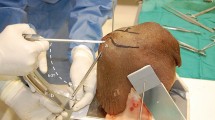Abstract
Purpose
This prospective study evaluated suprascapular nerve injury risk during arthroscopic superior labral repair in patients of average height or shorter.
Methods
From 2009 to 2011, 12 patients <179 cm tall undergoing arthroscopic superior labral repair were prospectively enrolled. Portal location, tear and anchor characteristics, and surgeon impression of medial glenoid wall perforation were collected. Suprascapular nerve conduction studies were obtained postoperatively. A musculoskeletal radiologist evaluated medial glenoid wall perforation and the distance from the anchor to the suprascapular neurovascular bundle on postoperative magnetic resonance images (MRI). DASH scores were recorded preoperatively and 6 months postoperatively.
Results
Medial wall perforation occurred in five (42 %) patients, with 3 patients having a single perforation and two patients having two perforations. Eight of 38 (21 %) anchors drilled into the superior half of the glenoid, and 6 of 20 (30 %) anchors inserted into the postero-superior quadrant of the glenoid, perforated the medial wall. Perforations occurred both through the portal of Wilmington and the antero-superior portal. The distance to the suprascapular neurovascular bundle from the perforating anchors ranged from 0 to 4 mm. Nerve conduction studies revealed subclinical signs of an incomplete nerve injury in one patient. DASH scores improved on average 29.3 points postoperatively (SD = 27.0, p = 0.007).
Conclusion
Medial wall perforation is common in smaller patients during arthroscopic superior labral repairs; the suprascapular nerve can be injured if perforation occurs. The clinical significance of these findings is unclear. In spite of a high drill-out rate, the nerve is rarely injured; however, an anchor designed for implantation into bone that is instead lodged in the soft tissues has the potential to harm these tissues and surrounding structures.
Level of evidence
Prospective cohort study, treatment study, Level III.





Similar content being viewed by others
References
Bailie DS, Moseley B, Lowe WR (1999) Surgical anatomy of the posterior shoulder: effects of arm position and anterior-inferior capsular shift. J Shoulder Elbow Surg 8(4):307–313
Bigliani LU, Dalsey RM, McCann PD et al (1990) An anatomical study of the suprascapular nerve. Arthroscopy 6(4):301–305
Burkhart SS, Morgan CD (1998) The peel-back mechanism: its role in producing and extending posterior type II SLAP lesions and its effect on SLAP repair rehabilitation. Arthroscopy 14(6):637–640
Chan H, Beaupre LA, Bouliane MJ (2010) Injury of the suprascapular nerve during arthroscopic repair of superior labral tears: an anatomic study. J Shoulder Elbow Surg 19(5):709–715
Gilmore J (1999) Body mass index and health. Health Rep 11(1):31–43
Gumina S, Albino P, Giaracuni M et al (2011) The safe zone for avoiding suprascapular nerve injury during shoulder arthroscopy: an anatomical study on 500 dry scapulae. J Shoulder Elbow Surg 20:1317–1322
Kim SH, Koh YG, Sung CH et al (2010) Iatrogenic suprascapular nerve injury after repair of type II SLAP lesion. Arthroscopy 26(7):1005–1008
Koh KH, Park WH, Lim TK et al (2011) Medial perforation of the glenoid neck following SLAP repair places the suprascapular nerve at risk: a cadaveric study. J Shoulder Elbow Surg 20(2):245–250
Lehtinen JT, Tingart MJ, Apreleva M et al (2003) Anatomy of the superior glenoid rim. repair of superior labral anterior to posterior tears. Am J Sports Med 31(2):257–260
Morgan CD, Burkhart SS, Palmeri M et al (1998) Type II SLAP lesions: three subtypes and their relationships to superior instability and rotator cuff tears. Arthroscopy 14(6):553–565
Rames RD, Karzel RP (1993) Injuries to the glenoid labrum, including slap lesions. OrthopClin North Am 24(1):45–53
Shishido H, Kikuchi S (2001) Injury of the suprascapular nerve in shoulder surgery: an anatomic study. J Shoulder Elbow Surg 10(4):372–376
Snyder SJ, Karzel RP, Del Pizzo W et al (1990) SLAP lesions of the shoulder. Arthroscopy 6(4):274–279
Trusler ML, Bryan WJ, Ilahi OA (2002) Anatomic and radiographic analysis of arthroscopic tack placement into the superior glenoid. Arthroscopy 18(4):366–371
Warner JJ, Micheli LJ, Arslanian LE (1992) Scapulothoracic motion in normal shoulders and shoulders with glenohumeral instability and impingement syndrome. a study using Moiré topographic analysis. Clin Orthop Relat Res. 285:191–199
Yoo JC, Lee YS, Ahn JH et al (2009) Isolated suprascapular nerve injury below the spinoglenoid notch after SLAP repair. J Shoulder Elbow Surg 18(4):e27–e29
Acknowledgments
This work was funded in part by the Edmonton Civic Employees Grant, Glenrose Foundation. Grant Number: RES0000001685. The following people also contributed to this work: Members of Shoulder and Upper Extremity Research Group of Edmonton (SURGE)—Rob Balyk, Joe Bergman, Jeff Bury, Robert Glasgow, AleemLalani. Judy Chepeha, Heather Bredy, Fiona Styles-Tripp, Charlene Luciak-Corea, Connie Lebrun, Holman Chan, Kyle Kemp.
Conflict of interest
None of the authors or their family members has any financial interest or conflict of interest with this work.
Author information
Authors and Affiliations
Corresponding author
Rights and permissions
About this article
Cite this article
Bouliane, M., Beaupre, L., Ashworth, N. et al. Suprascapular nerve injury during arthroscopic superior labral repair: a prospective evaluation. Knee Surg Sports Traumatol Arthrosc 23, 517–522 (2015). https://doi.org/10.1007/s00167-013-2415-1
Received:
Accepted:
Published:
Issue Date:
DOI: https://doi.org/10.1007/s00167-013-2415-1




